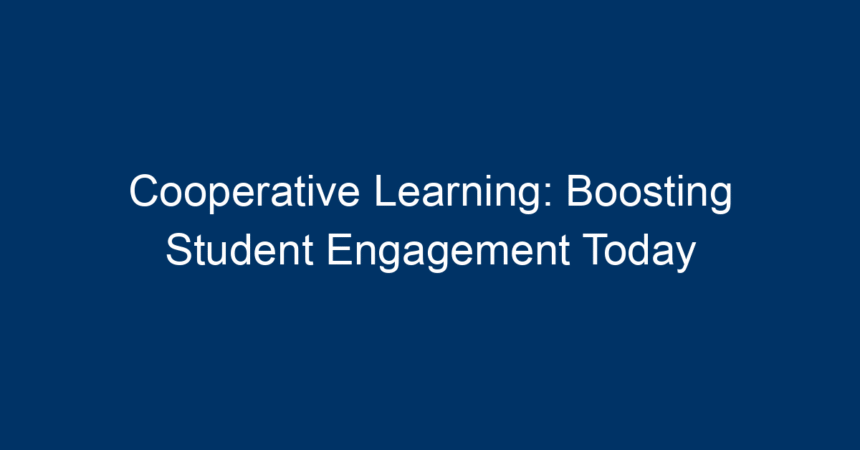In today’s fast-paced educational landscape, traditional teaching methods often fall short in capturing students’ attention and fostering deep engagement. Enter cooperative learning—a powerful approach that not only enhances student interaction but also cultivates critical skills essential for success in the 21st century. By leveraging the unique strengths of teamwork and collaboration, educators can create dynamic learning environments that actively involve students in the learning process. This article delves into the nuances of cooperative learning, its benefits, strategies for implementation, and actionable insights that can transform your classroom into a hub of engagement.
What is Cooperative Learning?
Cooperative learning is an instructional strategy that promotes student collaboration to achieve shared learning goals. Unlike competitive or individualistic learning environments, cooperative learning encourages students to work together in small groups, where each member contributes to the group’s overall success. This educational approach hinges on the belief that learning is inherently a social process, and it thrives on positive interdependence among students.
Core Principles of Cooperative Learning
- Positive Interdependence: Each member’s success is linked to the success of the group as a whole.
- Individual Accountability: While working in groups, each student is responsible for their own contribution.
- Face-to-Face Interaction: Students engage in meaningful discussions, promoting deeper understanding.
- Interpersonal and Small Group Skills: Students develop essential skills such as communication, conflict resolution, and leadership.
- Group Processing: Groups reflect on their collaboration and performance, identifying areas for improvement.
The Benefits of Cooperative Learning
1. Enhanced Student Engagement
One of the most significant advantages of cooperative learning is its ability to boost student engagement. When students collaborate, they are more likely to be actively involved in their learning. Group activities naturally spark interest, as students find motivation in working with peers and gaining diverse perspectives.
2. Improved Academic Achievement
Research consistently shows that students involved in cooperative learning outperform their peers in traditional settings. This is largely because group work promotes deeper understanding of material, as students explain concepts to each other and explore different viewpoints.
3. Development of Social Skills
In a cooperative learning environment, students learn to communicate effectively, listen actively, and resolve conflicts constructively. These social skills are invaluable, not only in academic settings but also in everyday life and future workplace scenarios.
4. Fostering Higher-order Thinking
Cooperative learning requires students to analyze, evaluate, and create, which can lead to higher-order thinking. Group discussions and problem-solving tasks compel students to engage critically with the material, fostering a deeper comprehension of complex topics.
5. Increased Self-esteem
Collaborating with peers can significantly boost a student’s self-esteem. As students contribute their ideas and insights, they gain confidence in their abilities, fostering a positive self-image that can enhance overall academic performance.
Effective Strategies for Implementing Cooperative Learning
1. Structured Group Work
To maximize the benefits of cooperative learning, it’s essential to structure group work thoughtfully. Assign roles within the group, such as facilitator, note-taker, or presenter, to ensure that all students are actively involved.
Example: In a science class, the facilitator can guide the discussion, while others research different aspects of a project. This strategy not only keeps everyone engaged but also helps students develop leadership skills.
2. Jigsaw Method
The Jigsaw method involves breaking a topic into parts and assigning each group member a section to become an expert on. After mastering their segment, students regroup to teach their peers about their area of expertise.
Example: In a history class, if the topic is World War II, one student can research the causes, another can cover major battles, and another can focus on the war’s aftermath. When they regroup, everyone shares their insights, providing a comprehensive understanding of the topic.
3. Think-Pair-Share
In this strategy, students first think about a question or problem individually, then pair up to discuss their thoughts before sharing with the larger group. This method encourages all students to contribute while promoting critical thinking and dialogue.
Example: In a literature class, after reading a chapter, students can first think about the main theme individually, discuss it with a partner, and then share their insights with the entire class.
4. Peer Teaching
Encourage students to teach one another. This strategy not only consolidates their own learning but also allows them to articulate concepts in a way that makes sense to their peers.
Example: In a mathematics class, once students learn a new concept, they can pair up and teach each other different problem-solving techniques for similar equations.
5. Use of Technology
Incorporating technology can enhance cooperative learning experiences. Use online tools that facilitate collaboration and allow students to communicate and share resources beyond the classroom walls.
Example: Platforms like Google Docs, Zoom, or Kahoot! can help students work together on projects or study sessions, regardless of their physical location.
Assessment in Cooperative Learning
Evaluating student performance in cooperative learning requires a different approach. Here are some strategies to consider:
- Group Assessments: Assess the group as a whole to encourage collaboration.
- Individual Assessments: Include individual components to ensure accountability.
- Peer Evaluations: Allow students to assess each other’s contributions, fostering accountability and reflection.
Criteria for Assessment
When assessing cooperative learning, consider the following factors:
- Contribution to Group Work
- Understanding of the Material
- Communication and Interpersonal Skills
- Overall Group Performance
Overcoming Challenges in Cooperative Learning
While cooperative learning offers numerous benefits, challenges may arise, including uneven participation and conflicts within groups. Here are some tips to mitigate these issues:
- Establish Clear Expectations: Clearly outline roles, responsibilities, and assessment criteria at the outset.
- Monitor Progress: Regularly check in with groups to address issues and keep everyone on track.
- Foster a Positive Environment: Encourage respect, open communication, and conflict resolution strategies within groups.
- Adapt Groups as Necessary: Be willing to reassign group members if conflicts or issues persist.
Conclusion: Actionable Insights for Boosting Engagement through Cooperative Learning
Incorporating cooperative learning into your teaching methodology can significantly enhance student engagement, foster collaboration, and improve academic merit. As educators strive to create more engaging and authentic learning experiences, embracing cooperative learning offers a practical means to achieve these goals.
To implement cooperative learning effectively:
- Begin with structured group activities to familiarize students with collaborative techniques.
- Utilize various cooperative learning strategies, like the Jigsaw method and Think-Pair-Share, to keep lessons dynamic.
- Assess both group and individual performances to encourage accountability and reflect on the learning process.
By integrating these strategies into your classroom, you can create a stimulating and inclusive environment that not only boosts engagement but also prepares students for collaborative success in the future. Engage your students today, and watch as they flourish collectively through the power of cooperative learning!




